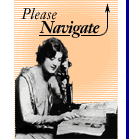| 1876 (March 10): |
In Boston, Alexander Graham Bell transmits the first complete message - "Mr. Watson, come here, I want you!" - with the use of his invention, the telephone. |
 |
|
1878 (July 30) to 1880 (April 17): |
A series of Massachusetts corporations controlling Mr. Bell's patent rights are organized. The first, Bell Telephone Co., is soon superseded by National Bell Telephone Co., which is replaced with American Bell Telephone Co. These firms supply telephone instruments to Bell-licensed exchange companies across the country that, in turn, rent them to local subscribers. |
 |
| 1885 (March 3): |
American Telephone and Telegraph Co. (AT&T) is established as a subsidiary of American Bell Telephone Co. Because the firm connects remote exchanges, it is popularly called the long-distance company. |
 |
| 1889: |
The first Bell logo is adopted. |
 |
| 1893 - 1894: |
Alexander Graham Bell's original telephone patents expire, spurring the formation of many independent telephone companies. Competition is fierce for the next 20 years. |
 |
| 1899 (December 30): |
AT&T succeeds American Bell as the parent of the Bell System. In general, the system's division of labor is as follows: AT&T offers strategic direction and support, its Long Lines Department manages long-distance service, Bell Telephone Laboratories (formed in 1925) conducts research and development, Western Electric Co. manufactures communications equipment and the Bell operation companies provide local phone service. |
 |
| 1900: |
The second Bell logo is introduced. |
 |
| 1910 (June 18): |
The Interstate Commerce Commission (ICC) assumes jurisdiction over interstate telephone companies.
|
 |
| 1913 (July 24): |
The U.S. Department of Justice files an antitrust suit against AT&T. The complaint charges the company with conspiracy to monopolize and restrain trade in northwestern states.
|
 |
| 1913 (December 19): |
In a letter to the U.S. attorney general, AT&T Vice President Nathan Kingsbury agrees to provide long-distance connection of Bell System lines to independent phone companies. He further agrees not to purchase competing independent without prior ICC approval. This letter is commonly known and the "Kingsbury Commitment".
|
 |
| 1914 (March 26): |
A consent decree ends the antitrust suit against AT&T. |
 |
| 1918 (July 1) to 1919 (June 30): |
The U.S. government runs the telephone system during the only time in American history. Although Bell System personnel handle daily operation, the postmaster general serves, in effect, as a super-chief executive officer. |
 |
| 1921: |
The third Bell logo is instituted. |
 |
| 1922 (October): |
The first broadcast of a football game (University of Chicago v. Princeton) is sent over telephone wire from Chicago to New York City. |
 |
| 1934 (June 19): |
President Franklin D. Roosevelt signs the Communications Act. The law places interstate telephone business under the regulation of the newly formed Federal Communications Commission (FCC). |
 |
| 1939: |
The fourth Bell logo is inaugurated. |
 |
| 1949 (January 14): |
The U.S. Department of Justice files suit against AT&T, charging that it conspired with Western Electric to monopolize trade in telephone equipment. The lawsuit attempts to separate the Bell System's manufacturing arm from its research and operating functions. |
 |
| 1950 - 1975: |
Over two and one third trillion - 2,300,000,000,000 - telephone calls go through Bell Systems central offices. |
 |
| 1956 (January 24): |
A consent decree, barring AT&T from engaging in unregulated businesses, brings to a close the Justice Department's antitrust suit against the company. Western Electric remains AT&T's largest single subsidiary. |
 |
| 1964: |
The fifth Bell logo is installed. |
 |
| 1968 (June 26): |
The FCC reaches its Carterfone decision. Carter Electronics of Dallas sought to interconnect its two-way radios with the nationwide phone system. The ruling strikes down interstate tariffs that prohibit attachment or connection of non-Bell System communications equipment to the public network. And it opens the way for competition in the customer-owned equipment market. |
 |
| 1969: |
The sixth and current Bell logo is unveiled. |
 |
| 1969 (August 13): |
The FCC approves the application of Microwave Communications, Inc. (MCI) to build a private line microwave communications system between Chicago and St. Louis. The action ultimately stimulates full competition in the long-distance phone business. |
 |
| 1971: |
Illinois Bell introduces Call Waiting, Three-Way Calling, Call Forwarding, and Speed Calling.
|
 |
| 1974 (November 20): |
The Justice Department files a final antitrust suit against AT&T, charging monopolization of the telecommunications service and equipment markets. |
 |
| 1977 (May): |
The test of the world's first network application of fiber optics begins in Chicago. The test proves that customer calls can be transmitted using light waves. |
 |
| 1982 (August 8): |
A federal court approves a consent decree breaking up the Bell System into local and long-distance telephone companies. AT&T agrees to divest itself of all Bell operating companies. The issue of which companies would retain rights to the Bell mark and logo is later decided in favor of Cincinnati Bell, Southern New England Telephone Co. (SNET) and the new holding companies, also called Regional Bell Operating Companies (RBOCs). |
 |
| 1984 (January 1): |
As a result of divestiture, the seven RBOCs - Ameritech, Bell Atlantic, BellSouth, NYNEX, Pacific Telesis Group, Southwestern Bell Corp. and U.S. West - become the parents of 22 local Bell companies. Cincinnati Bell and SNET, which were not wholly-owned subsidiaries of AT&T, carry on as distinct firms. 1984 coverage map. |
 |
| 1996 (February 8): |
President Clinton signs the Telecommunications Act of 1996. The law calls for the opening of local and long-distance telephone and cable television markets to full competition.
|
 |
| 1996 (August 1): |
The FCC issues its guidelines for bringing full competition to local and long-distance telephone markets.
|

BACK TO TOP |
